Summary of Matthias Grünewald
Grünewald is one of the most important artists in the history of Northern Renaissance Art, and one of the greatest of all German religious painters. Ignoring for the most part the rise of Renaissance classicism (unlike his famous contemporary Albrecht Dürer), Grünewald favored the irrational and mystical spiritual style of late medieval European art. His paintings were unique in the way he used expressive colouring and uneven line to present a personal take on religious parables that are renowned for their harrowing intensity. His Isenheim Altarpiece, now widely considered one of the most significant paintings in the history of Western art, secured Grünewald his worldwide reputation.
Accomplishments
- Grünewald - described by a seventeenth century biographer as the “German Caravaggio” - was unique amongst painters of his generation in the way he so explicitly showed the horror of pain and suffering through figural distortion. With swollen skin made postulant by flagellation and torture, his visions of Christ often appear revolting, but without ever losing sight of the theme of holy redemption.
- Grünewald was a painter of great technical ability who was even able to use grisaille to suggest effects of color, light and shadow, and depth in space. But it is for his stark and iridescent use of color that he is most admired. It was Grünewald’s combination of vivid coloring and animated gestures and expressions that distinguished him from his most eminent peers, Albrecht Dürer and Lucas Cranach the Elder.
- Although he proved willing to follow the “great discoveries” of the Italian Renaissance masters in the way he rendered the living flesh tones of his subjects, generally he rebutted the modern styles in favor of gothic-inspired images and late-medieval art. As the art historian E. H. Gombrich wrote “Grünewald’s work may […] remind us once more that an artist can be very great indeed without being ‘progressive”.
The Life of Matthias Grünewald

On his skill at blending the physical with the spiritual, E. H. Gombrich stated: “Just as he used his brush to depict the dead and tormented body of Christ”, so too did he use it “to convey […] an unearthly apparition of heavenly light”.
Important Art by Matthias Grünewald
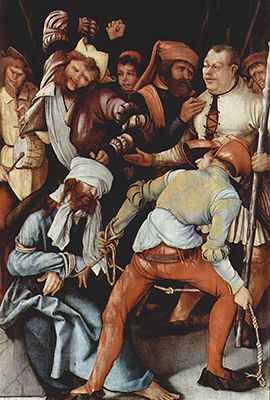
The Mocking of Christ
This painting is the first securely dated work of art attributed to Grünewald and demonstrates his style in its early stages of development. A blindfolded and bound Christ sits on a low surface in the bottom left foreground of the frame. His slumped shoulders and upturned lips suggest defeat, exhaustion, and an acceptance of his fate. To his right, a crouched figure pulls aggressively on the rope secured around his wrists. The top half of the painting is dominated by six men who attack and taunt Christ in diverse ways. Directly behind Christ, for example, a man tugs violently on his hair; about to strike him with his raised clenched fist.
While the composition may appear chaotic and confused, the densely packed figures that tower over the sitting figure of Christ create a palpable sense of claustrophobic tension. The painting also displays Grünewald’s nuanced treatment of color. Christ’s blue drapery, for instance, acts as a distinct foil against the dark and earthy tones of the other figures’ garments, thus strategically delineating him as the victim. The expressions of hatred, clearly visible on the faces of the soldiers attacking Christ, anticipate the intensity of emotion that will dominate Grünewald’s artistic oeuvre. As the art historian Robert Suckale states, in this painting, Grünewald “gives vent to the primeval force of emotion dominating his art”.
Oil on wood - Alte Pinakothek Museum, Munich, Germany
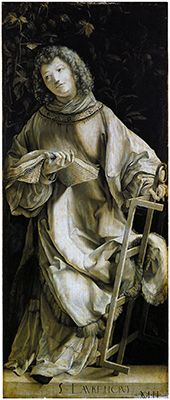
Panel of St. Lawrence: Heller Altarpiece
This painting depicts Saint Lawrence with his attribute of a metal gridiron (the instrument on which he was martyred). He gazes to the left with an expression of silent and sorrowful contemplation. In his right palm he balances pages of a manuscript. This work of art is executed entirely in grisaille (monochrome shades of grey). That, in addition to St Lawrence’s rather linear and static pose, suggests that the painted figure was meant to emulate a saintly statue or religious sculpture. Yet at the same time the animated drapery adds dynamism and movement to his otherwise static pose. The painting originally formed part of the two fixed wings of the Heller Altarpiece (by Albrecht Dürer) featuring a total of four painted saints (also in grisaille) and commissioned by the German merchant Jakob Heller.
The painting is a testament to Grünewald’s technical ability. Saint Lawrence’s hair has been rendered in delicate swirls of paint. Moreover, despite being rendered in grisaille; Grünewald has nonetheless managed to suggest effects of color, shading, and even three-dimensionality. The creases and chiaroscuro of the drapery in particular convey the depth and form of Saint Lawrence’s body. In the bottom right corner, Grünewald has signed the painting with the monogram M.G.N. thus confirming that he was originally known as Mathis Gothardt Neithart.
Oil on panel - Städel Museum, Frankfurt, Germany
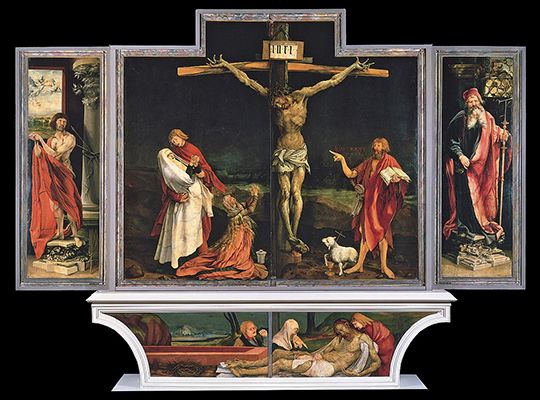
The Crucifixion: Isenheim Altarpiece
This painting’s composition is dominated by the body of Christ hanging from a crucifix placed unusually close to the ground. His body is taut and entirely covered in lacerations and blistering spots of pox (some containing small thorns). His fingers are extended in agony. His feet, which are nailed to a projection on the crucifix, are horrifically distorted. He is the epitome of physical suffering, and he looks to have died on the cross. The left side of the painting features three mourning figures: a kneeling Mary Magdalene, and a swooning Virgin Mary supported by St John the Evangelist. Mary Magdalene’s hands are clasped in an ardent gesture of desperation and distress. On the right, the figure of St John the Baptist points calmly towards the body of Christ and holds a Bible. A red inscription reads: “he must increase, but I must decrease”. St. John the Baptist is accompanied by a lamb with a cross that is bleeding from a wound in his chest; the lamb both an attribute the Baptist and a recognised Eucharistic symbol of Christ and his passion.
The painting forms part of Grünewald’s largest and most significant commission: the famed Isenheim Altarpiece. Grünewald’s principal source for Christ’s intensely mangled and damaged body was the fourteenth century Revelations by St Bridget. While it was common to dramatize the agony and torment of Christ’s passion in German devotional art of the late Middle Ages, Grünewald’s picture of Christ is unsurpassed in its unflinching depiction of suffering and pain. In the words of Robert Suckale, this painting “portrays the agony of Christ with a penetrating forcefulness seen neither before nor since”, while the American psychiatrist and author Charles W. Socarides describes “an affect of pathos to the point of distortion”.
The altarpiece was commissioned by the Antonite Order for the hospital at their monastery in Isenheim, Alsace. The hospital primarily treated skin diseases, including St Anthony’s Fire (what is today known as ergotism). The patients of the hospital would likely have identified with Christ’s torment and pain, and the hospital staff would have been encouraged to treat their patients as they would Christ. The painting also offers the hope of salvation after suffering; a comforting thought in a hospital setting. It suggests that true healing will come from Christ and faith in his sacrifice. Sombre, dramatic, and affecting, the Altarpiece is Grünewald’s uncontested masterpiece.
Oil on wood - Unterlinden Museum at Colmar, Alsace, France
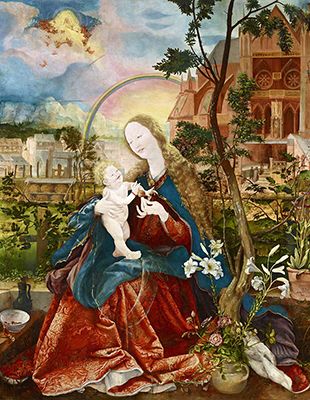
Stuppach Madonna
Stuppach Madonna portrays the Virgin Mary and Christ child amid a luscious backdrop. The two figures smile joyfully as the Virgin presents her son with what appears to be a fig. The background is composed of an enchanting landscape featuring vibrant greens, blue faraway mountains, a townscape, and a prominent and accurate rendition of Strasbourg Cathedral. The rainbow in the background and the vivid colours grant this painting an ethereal and mystical quality that heightens its religious fervour.
This painting is considered one of Grünewald’s principal works. It was commissioned by Stiftskanonikus Reitzmann to be part of an altarpiece for a collegiate church in Aschaffenburg. Mary’s elongated fingers and her dainty features point towards the influence of Late Medieval panel painting on Grünewald’s style. Rather than re-awakening the classicism of ancient Greece or Rome (in line with the Italian Renaissance), Grünewald revived Gothic forms. However, his Virgin Mary and Christ Child are uniquely fleshier than those of the Late Gothic.
This painting is full of religious symbolism and established iconography which confirms Grünewald’s own pious faith. In the foreground of the painting, a fig tree, and a vase of lilies echo the Virgin Mary and the Christ Child. Lilies are typically represented with the Virgin Mary, and the fig tree is a recognised symbol of Christ. The church façade (in the right background) and the prominent rainbow (in place of what one would expect to be Mary’s halo) both portray Grünewald's reliance on the Revelations of St Bridget of Sweden as a principal source for this painting in which St Bridge describes Mary as the guardian of the church and invites an analogy between the Virgin Mary and a rainbow. Art historian John Gage suggests that Grunewald’s iconography may have also been partly inspired by the early writings of St Bonaventure (Laus Virginus, 6) in which the colours blue and red (the two main prominent colours of Grünewald’s rainbow) are linked to virginity and charity.
Mixed Media on Wood - Parish Church of the Coronation of the Virgin, Stuppach, Germany

The Meeting of Saint Erasmus and Maurice
In this painting, four figures are seen conversing amongst themselves. St Erasmus, the former bishop of Antioch, stands to the left. He is dressed in an opulent gold bishop’s gown, and he holds a windlass, the instrument that was used to suck intestines from the body. He converses with St Maurice (on the right); a black knight who is depicted clad in armour and gesticulating emphatically with his right open palm. He is also shown wearing a jewelled headdress. Each figure is accompanied by an attendant who shadows them in the background.
This work is perhaps Grünewald’s most opulent painting. It was executed for the Cardinal and Elector Albrecht von Gemmingen (Archbishop of Mainz) for whom Matthias worked as court painter until 1525. Von Gemmingen commissioned the painting as part of his renovation plans for the monastery at Halle which explains the choice saints in the painting. St Maurice was the patron saint of the monastery in Halle, and St Erasmus was important to Albrecht as he had his relics transported from Magdeburg to Halle in order to attract German pilgrimage to the city. In the painting, Saint Erasmus is in fact a portrait of the Cardinal. It has been discovered by historians that this prominent portrait is based on an engraving by Albrecht Dürer entitled Little Cardinal (1519).
This painting depicts a very important theme in German art of the time: religious debate. However, it is not clear what theme is under discussion. This artwork also reveals the progression and development of Grünewald’s later style. Professor of Art History, Craig S. Harbison writes: “In this painting as well as in the late, two-sided panel known as the Tauberbischofsheim Altarpiece, Grünewald’s forms become more massive and compact, his colours restrained but still vivid”.
Oil on panel - Alte Pinakothek Museum, Munich, Germany
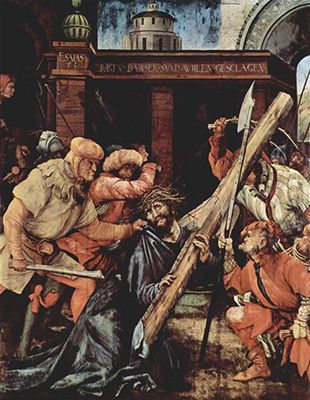
Christ Carrying the Cross
Christ slumps on his knees in the centre of this composition. He has collapsed while carrying the heavy cross on the way to his own Crucifixion. He gazes upwards in exasperation. His back is dramatically and angularly arched, thus evoking a sense of discomfort, pain, and suffering. Christ is surrounded on both sides by armed henchmen that taunt and mock him. A man to Christ’s left tugs aggressively on his drapery, forcing him to continue his journey. A crouching figure on the right stares hostilely at Christ. The background of the painting is composed of medieval architecture that represents the city of Jerusalem. The ledge of the loggia bears an inscription from The Book of Isaiah.
This work encapsulates the religious paintings of Grünewald which are intense and emotionally expressive (particularly his scenes of Christ in agony). Here, Christ’s torture and suffering has been amplified to create an emotionally tugging work of art. As art historian Arthur Burkhard claims, the brutality and fierce hatred visible on the surrounding soldiers’ faces betrays Grünewald’s “preference for emotional extremes” and his unmatched ability to evoke them. Like all his paintings, the figures depicted are not classicized, but inspired by Gothic Art. Yet the painting (like others) is also indebted to the Italian masters in his rendering of realistic skin tones. It was this ability to bring existing styles into new formal relationships that gave Grünewald’s art such a distinct personal style.
Oil on wood - Staatliche Kunsthalle Karlsruhe, Karlsruhe, Germany
Biography of Matthias Grünewald
Childhood and Education
Mathis Gothardt Neithart was probably born in Würzburg, Germany sometime between 1470-75. The name Matthias Grünewald was mistakenly given to him by the seventeenth-century German painter and writer, and the artist’s first ardent admirer, Joachim van Sandrart, who wrote Grünewald’s first biographical record for the dictionary, Teutsche Academie der Bau-, Bild- und Mahlerey-Künste (German Academy of the Noble Arts of Architecture, Sculpture and Painting) published in 1675, 1679 and 1680. It has remained a source book for historians and critics ever since. But, as the famous art historian E. H. Gombrich noted, while his contemporary Albrecht Dürer “stands before us like a living human being whose habits, tastes and mannerisms are intimately known to us, Grünewald is as great a mystery to us as Shakespeare”.
In several sources Grünewald is named as common “Meister Mathis” which has made substantiating details of his formative years a speculative task at best. Some authors have suggested that he may have been a pupil of Hans Holbein the Elder the Elder. However, Grünewald’s name first appears as a “free master” in official documents dated 1500, for the small Offenbach town of Seligenstadt where he purchased a house (“with a pond”) and opened a workshop for painters and woodcarvers. But, unlike Dürer, and his other famous contemporary, Lucas Cranach the Elder, there is no evidence that Grünewald took on any pupils or apprentices (not at this early stage in his career at least).
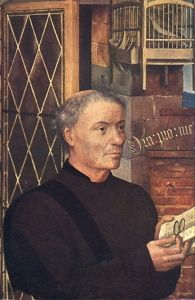
The earliest complete work attributed to him is Benefactor with a Bird Cage (c. 1500). The "Benefactor" of the title holds in his hands a miniature pince-nez and a book (most likely of religious text) while the bird cage in the upper right corner is probably home to a songbird. Although nothing is known of its origins, the painting has been dated around 1500 because of Grunewald’s subdued color scheme would seem to predate his subsequent religious works which favor more dynamic color combinations. Indeed, his next known work, The Mocking of Christ (1504-06), offers a vigorous and distorted vision of a blindfolded Christ being beaten by a gang of grotesques. It is a much more indicative piece (than the Benefactor) and was thought to be part of an epitaph for the aristocrat Baroness Apollonia von Cronberg of Cronberg who died in 1503.
Von Sandrart, writes that in 1505 Grünewald was in Frankfurt working on the outer adornment of an altarpiece by Dürer. Considering that it was the kind of work typically assigned to someone of limited experience, it is speculated that Grünewald was being employed by Dürer in the capacity of apprentice. Official records confirm for us, however, that Grünewald was commissioned to paint and inscribe the epigraph of Johann Reitzmann, the vicar of a collegiate church in Aschaffenburg, around the same time. By 1509-10 Grünewald’s reputation was such he become court painter - or “clerk of the works” to give him his official title - for two archbishops for the city of Mainz: Uriel von Gemmingen and, following his death in 1514, Albrecht von Brandenburg. The post was the first significant step in his career, and he held it for around 15 years in total.
Mature Period
Grünewald started to receive important commissions from this date too. In 1510 he was asked by the German merchant, Jakob Heller, to execute four grisaille saints for the fixed wings of the Dürer Altarpiece, Assumption of the Virgin. The wings, according to the art historian Craig S. Harbison, “already show the artist at the height of his powers […] Like Grünewald’s drawings, which are done primarily in black chalk with some yellow or white highlighting, the Heller wings convey colouristic effects without the use of colour. Expressive hands and active draperies help blur the boundaries between cold stone and living form”. In addition to his career as a painter, Grünewald also worked as a hydraulic engineer. It is documented that he repaired a fountain in Bingen in 1510. (Civic records suggest that he continued to work periodically on fountain and water works until his premature death in his late-‘40s or early-‘50s.)
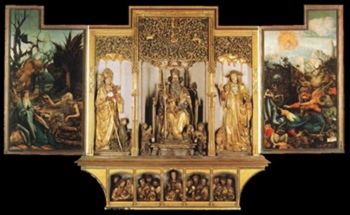
In 1512 Grünewald started work on his most important work, and what is now universally considered his masterpiece, the Isenheim Altarpiece, for the hospital at the monastery of Saint Anthony in Isenheim, Alsace. The monumental project was commissioned by the Italian knight Guido Guersi who was the head of the religious community at the Antonite monastery. Grünewald was asked to paint three sets of wings – which included scenes of the Crucifixion, the Nativity and the Temptation of Anthony - for the High Altar shrine that had been carved by Niclaus Hagnower of Strasbourg in 1505.
As Harbison writes, “The subject matter of the wings […] provided Grünewald’s genius with its fullest expression and was based largely on the text of the popular, mystical Revelations of St. Bridget of Sweden (written about 1370) […] The colours used are simultaneously biting and brooding” and express “deep spiritual mysteries [that] are perhaps the most spectacular found in German art until the late 19th century”. It was a view shared by historian John Oliver Hand who wrote, “In terms of its emotional power, expressive, often radiant color, and gruesome depictions of suffering, the Isenheim Altar is without parallel in northern European art”.

Grünewald followed the Isenheim Altarpiece in 1517 with a prestigious commission for Canon Heinrich Reitzmann for the collegiate church at Aschaffenburg. Although the work is no longer intact, the original frame of the altarpiece Our Lady of the Snow remains. It is dated 1519 and shows the monogram “MG” (in ligature) below an “N”, providing confirmation that it was an original work by Mathis Gothart Neithart.
In 1519 Grünewald married to a converted Jewish woman named Anna Neithardt. Civic documents show that Grünewald sometimes added his wife’s surname to his own – as in Mathis Neithardt or Mathis Gothardt Neithardt – but Anna suffered from mental health problems which badly affected the couple’s home life. Indeed, having become convinced she was host to a demonic spirit, Anna was committed to a mental institution in 1523.
Late Period
In 1520, Cardinal von Brandenburg, having now succeeded von Gemmingen as the elector of Mainz, commissioned Grünewald to paint The Meeting of SS. Erasmus and Maurice (the figure of Erasmus thought to be a vanity portrait of the Cardinal himself) and bears close seminaries to Dürer's 1519 engraving, Little Cardinal. The work was part of von Brandenburg’s renovation plans for the monastery of Halle which included relocating relics and artworks from Magdeburg with the aim of increasing German pilgrimage to the city (Halle). Art historian Julia Alcamo explains “This elaborate, and beautifully executed oil panel depicts the meeting of two important figures relevant to the city and its ruler. Saint Maurice was the patron saint of the monastery while Saint Erasmus was the patron saint of Albrecht’s royal household […] The wooden panel depicts the theme of religious discussion and debate, an important theme for this period of German art”.
Sandrart writes that at some point, most likely towards the end of his career (after 1520), Grünewald apprenticed the painter Hans Grimmer who garnered considerable fame during his lifetime. In 1526, Grünewald gave up his position as von Brandenburg’s court painter, and moved to Frankfurt where he stayed with the silk embroiderer Hans von Saarbrucken. There is some speculation as to why Grünewald chose to give up his post. The most likely suggestion is that Grünewald, who had become sympathetic to the Protestant cause, could no longer work in the services of the Catholic church. Indeed, he was directly implicated in the Great Peasants’ Revolt (brought on by the Reformation which promoted the “divine law” that demanded freedom from oppression by nobles and landlords) of 1525.
By 1527 Grünewald was living in Halle with a child (possibly his own or, perhaps, adopted) where he worked for the wealthy von Erbach family. He also resumed his interest in hydraulic engineering and was involved in the supervision of Halle’s water systems. Grünewald died, probably a result of a flu epidemic, in Halle on August 31, 1528. Hand noted that the recorded inventory of his possessions offered a “fascinating document, listing what appears to be expensive clothing for court use, artist's materials, pigments in particular, coins and medals, two paintings, copies of Luther's sermons and a New Testament (the latter described [in the document] as ‘Lutheran trash’)”.
The Legacy of Matthias Grünewald
While he is today considered one of Germany’s greatest painters - Grünewald (with Albrecht Dürer and Lucas Cranach) is commemorated by the Lutheran Church each year (on April 6) as both an artist and saint - his reputation has over the centuries suffered highs and lows. The importance of his commissions confirm his standing on his own lifetime, but Grünewald was almost completely forgotten by the end of the seventeenth century and was only “rediscovered” in the nineteenth century when his dramatic and expressive forms caught the attention of German Expressionists and Neo-Classicists alike. Since then, his critical “rebirth”, helped no doubt by his known involvement in the Peasants’ War which drew the admiration of leftist intellectuals, has offered inspiration for important artists, composers and writers.
Grünewald’s use of vivid coloring, animated gestures, exaggerated expressions, and renderings of the often-tortured human body, have provided inspiration for artists including Pablo Picasso, Otto Dix, Francis Bacon and Jasper Johns, who traced the Isenheim Altarpiece onto his own work. In the sphere of musical drama, Paul Hindemith’s 1938 opera Mathis der Maler is based on Grünewald’s involvement in the Peasants’ War, with three movements - “Angel Concert,” “Entombment,” and “The Temptation of St Anthony” - named after three paintings in the Isenheim Altarpiece. For his first piece of prose, After Nature (1988) the German author W. G. Sebald narrates the life story of Grünewald, focusing particularly on his execution of the Isenheim Altarpiece, while the Altarpiece also makes an appearance in Sebald’s novel, The Emigrants (1992), in which it serves as a reference point for the protagonist’s deliberations on pain and power. Lastly, the French novelist and journalist, Joris-Karl Huysmans promoted Grünewald’s art so passionately some have drawn comparisons with Marcel Proust’s exaltation of Johannes Vermeer.
Influences and Connections

-
![Albrecht Dürer]() Albrecht Dürer
Albrecht Dürer - Lucas Cranach
- Martin Schongauer
-
![High Renaissance]() High Renaissance
High Renaissance - Late Medieval Panel Painting (Late Gothic)
- Flemish Art
- Hans Grimmer
- Hans von Saarbrucken
-
![New Objectivity]() New Objectivity
New Objectivity -
![Dada]() Dada
Dada -
![Surrealism]() Surrealism
Surrealism -
![German Expressionism]() German Expressionism
German Expressionism - Berlin Dada
Useful Resources on Matthias Grünewald
- The Story of ArtBy E. H. Gombrich
- Matthias Gruenewald: The DrawingsBy Michael Roth, Rüdiger Becksmann, Matthias Grünewald
- Der historische Grünewald. Mathis Gothardt-NeithardtOur PickBy Walter Karl Zülch
- Matthias Grünewald: Personality and AccomplishmentOur PickBy Arthur Burkhard
- The Devil at Isenheim: Reflections of Popular Belief in Grünewald's AltarpieceOur PickBy Ruth Mellinkoff
- German Paintings of the Fifteenth through Seventeenth CenturiesOur PickBy John Oliver Hand, Sally E. Mansfield
- The Isenheim Altarpiece: God's Medicine and the Painter's VisionOur PickBy Andrée Hayum
- Color and Culture: Practice and Meaning from Antiquity to AbstractionBy John Gage
- History of Art: The Western TraditionBy Anthony F. Janson, Horst Woldemar Janson
- The World's Most Influential Painters and the Artists They InspiredBy Dennis P. Weller, et al.
- Images and relics: theological perceptions and visual images in sixteenth-century EuropeBy John Dillenberger
- German Paintings of the Fifteenth Through Seventeenth CenturiesBy Sally E. Mansfield, John Oliver Hand
 Ask The Art Story AI
Ask The Art Story AI
















